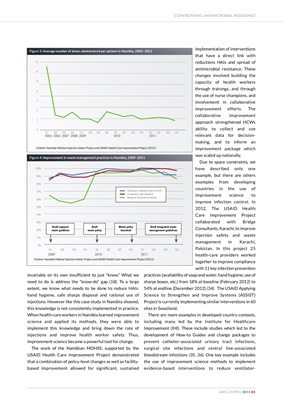
invariably on its own insufficient to just "know." What we
need to do is address the "know-do" gap (18). To a large
extent, we know what needs to be done to reduce HAIs:
hand hygiene, safe sharps disposal and rational use of
injections. However like this case study in Namibia showed,
this knowledge is not consistently implemented in practice.
When health-care workers in Namibia learned improvement
science and applied its methods, they were able to
implement this knowledge and bring down the rate of
injections and improve health worker safety. Thus,
improvement science became a powerful tool for change.
The work of the Namibian MOHSS, supported by the
USAID Health Care Improvement Project demonstrated
that a combination of policy-level changes as well as facilitybased
improvement allowed for significant, sustained
implementation of interventions
that have a direct link with
reductions HAIs and spread of
antimicrobial resistance. These
changes involved building the
capacity of health workers
through trainings, and through
the use of nurse champions, and
involvement in collaborative
improvement efforts. The
collaborative improvement
approach strengthened HCWs
ability to collect and use
relevant data for decisionmaking,
and to inform an
improvement package which
was scaled up nationally.
Due to space constraints, we
have described only one
example, but there are others
examples from developing
countries in the use of
improvement science to
improve infection control. In
2012, The USAID Health
Care Improvement Project
collaborated with Bridge
Consultants, Karachi, to improve
injection safety and waste
management in Karachi,
Pakistan. In this project 25
health-care providers worked
together to improve compliance
with 11 key infection prevention
practices (availability of soap and water, hand hygiene, use of
sharps boxes, etc.) from 18% at baseline (February 2012) to
54% at endline (December 2012) (34). The USAID Applying
Science to Strengthen and Improve Systems (ASSIST)
Project is currently implementing similar interventions in 60
sites in Swaziland.
There are more examples in developed country contexts,
including many led by the Institute for Healthcare
Improvement (IHI). These include studies which led to the
development of How-to Guides and change packages to
prevent catheter-associated urinary tract infections,
surgical site infections and central line-associated
bloodstream infections (35, 36). One key example includes
the use of improvement science methods to implement
evidence-based interventions to reduce ventilatorCONFRONTING
ANTIMICROBIAL RESISTANCE
AMR CONTROL 2015 85
12
10
8
6
4
2
2
0
Q1 Q2 Q3 Q4 Q1 Q2 Q3 Q4 Q1 Q2 Q3 Q4 Q1 Q2 Q3 Q4
2004 2006 2007 2008 2009 2010 2011
Figure 3: Average number of doses administered per patient in Namibia, 2005-2011
Q1 Q2 Q3 Q4 Q1 Q2 Q3 Q4 Q1 Q2 Q3 Q4
2009 2010 2011
100%
90%
80%
70%
60%
50%
40%
30%
20%
10%
0%
Draft regional
waste guidlines
Draft
waste policy
Waste policy
launched
Draft integrated waste
management guidelines
Containers replaced when 3/4 full
Containers meet standard
Access to functinal incinerator
Figure 4: Improvement in waste management practices in Namibia, 2009-2011
Citation: Namibia Medical Injection Safety Project and USAID Health Care Improvement Project (2011)
Citation: Namibia Medical Injection Safety Project and USAID Health Care Improvement Project (2011)